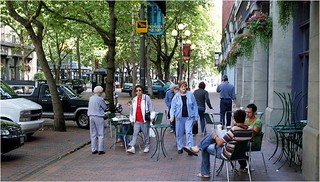40 percent of Americans believe their neighborhoods are not walkable

Posted October 3, 2013 at 3:04PM
79 percent of Americans believe they should walk more, but forty percent say they do not do so because their neighborhoods do not have nearby services, shops, schools and work, according to a national survey released this week.
The lack of nearby walkable destinations ranks as the second most often cited reason for not walking. The survey found that the biggest neighborhood barriers to walking include a lack of sidewalks, drivers who speed, and drivers who talk on their phones or text. Crime ranks eighth overall out of 15 items as a neighborhood barrier to walking, but it ranks 5th among both African Americans and Hispanic respondents compared to 12th among white respondents.
The survey of 1,224 Americans nationwide was commissioned by Kaiser Permanente and conducted by GfK Custom Research. Assisting in the design of the questionnaire and analysis of the data were Professors Peter Tuckel and William Milczarski of Hunter College, City University of New York. All interviewing took place August 5th to August 13th, 2013.
While six in 10 Americans describe their neighborhood as “walkable,” individuals who live in more walkable neighborhoods (“with places where it is convenient to walk to services, shopping, schools and jobs”) do, in fact, walk more. Four in 10 describe their neighborhood as “not very” or “not at all walkable.” A majority of Americans do not choose their neighborhood based on its perceived walkability, however.
These findings were presented at yesterday’s session of the National Walk Summit in Washington, DC, which I attended. Christopher Fleury of GfK added at the meeting that a slim majority of the respondents support smart growth measures, including smaller home lots, to promote walkability.
 Although Americans don’t walk as much as they believe they should, an overwhelming majority recognize that walking brings significant benefits. Nationwide, 94 percent of those surveyed said they view walking as good for their health. At least nine in 10 agreed that walking is a good way to lose weight, maintain a healthy weight and can help prevent heart disease. In addition, 73 percent said they believe their children should walk more. (For a good summary of the many benefits of walking, go here.)
Although Americans don’t walk as much as they believe they should, an overwhelming majority recognize that walking brings significant benefits. Nationwide, 94 percent of those surveyed said they view walking as good for their health. At least nine in 10 agreed that walking is a good way to lose weight, maintain a healthy weight and can help prevent heart disease. In addition, 73 percent said they believe their children should walk more. (For a good summary of the many benefits of walking, go here.)
Americans also view walking as a good way to reduce stress and combat depression. More than eight in 10 respondents said that walking can reduce feelings of depression and 87 percent said walking helps reduce anxiety.
While the survey findings are encouraging to those of us who believe that land use factors are important to a healthy lifestyle, at least two audience members cautioned that, in their parts of the country, “walkability” was perceived as threatening to those who prefer suburban lifestyles. They advised that advocates should guard against using “walkable” as code for “high density.”
Although it was surprising to me that even “walkable” is now on the list of threatening planners’ jargon, I do think the fear of high density is real. Those of us who live and work in big cities can get a distorted view of what is desirable. I think advocates need to get serious about supporting moderate-density alternatives in appropriate situations, along with neighborhood design measures that can soften the otherwise harsh effects of density.
Indeed, the research demonstrates that most of the environmental benefits of smart growth – including reduced automobile dependence and reduced stormwater runoff per capita – do not require high densities: the biggest performance improvements come at the lower end of the scale, as we move from large-lot sprawl to moderate degrees of compactness and, by the time we reach 40 to 50 units per acre, further environmental performance improvements are relatively insignificant. A dialogue about these issues is largely missing from the current discourse around smart growth, and that is unfortunate.
Related posts:
- The disturbing and sometimes tragic challenge of walking in America (January 16, 2013)
- How far will we walk to go somewhere? It depends. (July 30, 2012)
- Data summaries show walkable communities are good for our health, and for business, too (April 13, 2012)
- 5 graphs and 4 photos tell the story on obesity, diabetes & walking (March 28, 2012)
- When shops and services are within walking distance, we walk more and drive less (January 11, 2012)
Move your cursor over the images for credit information.
